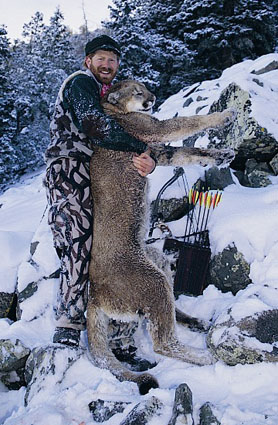 |
What was your New Year’s resolution last year? Was it to lose weight? Maybe give up chocolate? Be nicer to your wife’s cat?
Resolutions are often made with good intentions, but they seldom endure. If you are like most folks you probably went to the gym for a week or two, gave up chocolate until no one was looking, and that lousy cat probably still runs for cover when you enter the room.
My resolution every year is simple—hunt more! The months from January through June are full of opportunities for archers. Some options are close to home and affordable, such as calling cold-weather coyotes. Other hunts offer the chance to escape snow-packed driveways and embark on a new adventure in a warmer landscape, such as stalking javelina in the sunny deserts of the Southwest. Other options include hunting cougars with hounds, guarding bait for a hungry black bear, calling spring gobblers, and even a hunt for colorful exotics. Here’s a look at when to go, where your odds for success are the best, and important equipment for bowhunting during the first six months of the year.
Cougars
After a frigid chase covering several miles in freezing temperatures and deep snow, I was finally standing just 10 yards from a BIG male cougar. Three hound dogs barked excitedly below the treed tomcat. The barking was so loud I could barely hear myself think. When the cat appeared nervous and seemed ready to abandon his perch, I drew and pierced the cat’s lungs. In an explosion of snow-covered branches and scalpel-sharp claws, the 150-pound cougar came tumbling out of the sky. He charged down the steep hillside in long, uncontrollable strides until he died on a snow- and ice-covered boulder field halfway down the canyon.
I consider the two cougars I’ve arrowed as hard-earned trophies and memories from real Western adventures. Hunting with keen-nosed hounds is the only reliable way to find mountain lions. Without a doubt, snow is the lion hunter’s best ally, showing fresh prints easily and holding the cat’s scent for sniffing mutts. Hunts start early each morning either in pickup trucks, aboard snowmobiles or on horseback in search of fresh tracks.
Once a good-sized print is located, if the track is fresh enough, the dogs are turned loose and the race is on. The chase might last 30 minutes or it could last all day. Seeing a big tom cat framed by prickly pine needles at the top of a tree and surrounded by excited bawling hounds is a truly a reward for a long, exhausting chase.
The demands of cougar hunting require being in top physical condition. A ragged chase through mountainous terrain is no place for a weak body or fragile equipment. Top-quality boots are ideal for getting good traction on snow-covered slopes. Wool and fleece are ideal clothing materials in cold, wet weather. Wear a daypack filled with snacks, sports drinks, and an extra release if you’re a release shooter. Shots at treed cougars are usually at less than 20 yards, but often at extreme upward angles.
Many Western states and Canadian provinces offer excellent cougar hunting. Idaho, Utah, Montana, Colorado and New Mexico have a consistent track record of producing big cats.
Next: Coyotes, Javelinas






